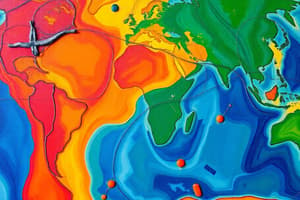Podcast
Questions and Answers
What is the main driving force of plate movement, according to the text?
What is the main driving force of plate movement, according to the text?
- Ridge push from the formation of new lithosphere at divergent margins
- Upwelling magma injections at divergent margins
- Slab pull from the subduction of cold, dense slabs (correct)
- Convection currents pushing plates apart at divergent margins
What is the main reason why the idea of upwelling magma injections as a driving force is disregarded?
What is the main reason why the idea of upwelling magma injections as a driving force is disregarded?
- It does not create new lithosphere at divergent margins
- It does not contribute to the slab pull process
- Tomography scans have shown it to be incorrect
- It does not reduce pressure on the underlying asthenosphere (correct)
What is the thickness range of continental plates?
What is the thickness range of continental plates?
- 1-8 km
- 10-25 km
- 50-75 km (correct)
- 5-15 km
What process extends and thins plates at divergent margins?
What process extends and thins plates at divergent margins?
What are primary tectonic hazards?
What are primary tectonic hazards?
What is the key to understanding the spatial geography of earthquakes and volcanoes?
What is the key to understanding the spatial geography of earthquakes and volcanoes?
What happens at passive margins between different types of plates?
What happens at passive margins between different types of plates?
What is the composition of most tectonic plates?
What is the composition of most tectonic plates?
What is the physical state on which plates move?
What is the physical state on which plates move?



